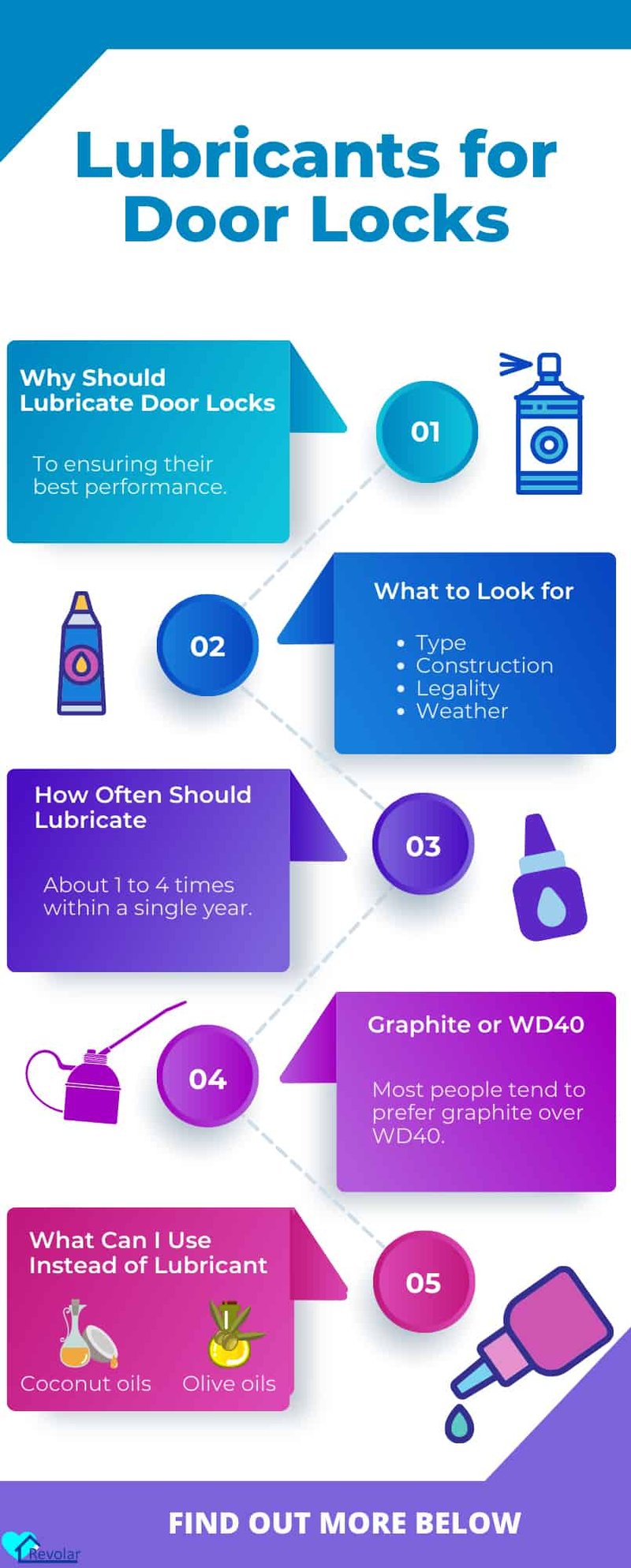
Here’s the thing: deadbolts in high-traffic entryways face a level of wear and tear that’s easy to underestimate. People slam, jiggle, and twist those locks hundreds—sometimes thousands—of times a month. Without regular care, even the sturdiest brands like Schlage or Kwikset will start sticking, jamming, or refusing to budge at the worst possible time. Think of it like a bike chain: skip the oil, and suddenly everything grinds and squeaks. Give it some timely attention, and everything just works. Honestly, keeping up with a simple lubrication schedule can be the difference between a lock that lasts for years and one that needs replacing far too soon.
Why Lubrication Matters For Deadbolts Used Every Day
Let me explain: lubrication isn’t just about stopping a squeak or making your key turn a bit smoother. On heavily-used deadbolts, it’s the main line of defense against wear, corrosion, and that slow build-up of gunk that makes a lock feel sticky. Every time someone uses the door, tiny metal parts are scraping and sliding over each other. Without enough lubrication, metal starts grinding against metal—and over time, that means the lock can seize up entirely.
What’s more, high-traffic entryways tend to collect more dust, dirt, and moisture. People drag in rain, snow, sand, and the occasional rogue leaf, and all of it can work its way into your deadbolt. A good lubricant not only reduces friction but can help flush out debris and repel moisture. That’s why reputable brands like Schlage, Yale, and Kwikset recommend a regular maintenance routine for locks in busy areas.
Don’t forget, skipping lubrication doesn’t just make things harder for users. It can also void some manufacturer warranties, especially for commercial-grade deadbolts. So, keeping up with a reasonable lubrication schedule isn’t just good practice—it can actually save you money, hassle, and unexpected lockouts.
How Often Should You Lubricate A High-Traffic Deadbolt?
You might be wondering if there’s a magic number, like “every 100 turns” or “once a month on the dot.” While every situation is a bit different, here are some general guidelines I’ve found work for most busy entryways:
- Every 3 months: For doors used dozens of times a day—think offices, apartment lobbies, retail entrances—quarterly lubrication is the sweet spot. This keeps everything running smooth and helps prevent sudden failures.
- Every 6 months: For busy homes or smaller workplaces, twice a year usually does the trick. If you notice things feel gritty or stiff sooner, don’t wait—just go ahead and lubricate as needed.
- After any deep clean or big weather change: If you’ve just pressure-washed the stoop or had a huge rainstorm, it’s a good idea to give your deadbolt some extra attention. Water and cleaning chemicals can flush away lubricants or cause premature rust.
Of course, if you start feeling resistance, hearing grinding, or seeing visible grime, don’t stick to the schedule—take action sooner. High-traffic doors can surprise you with how quickly they wear down, especially during cold snaps or humid summers.
Best Lubricants For Deadbolts: What To Use And What To Skip
Not all lubricants are created equal. Here’s where a lot of folks get tripped up. You might reach for whatever’s under the sink—WD-40, cooking spray (please don’t), or a bit of grease. But deadbolts, especially those from premium brands like Schlage or Medeco, need something designed for the job.
- Dry graphite powder: This is the classic choice for most pin tumbler locks. It doesn’t attract dirt, works in cold temperatures, and leaves behind a slick, residue-free coating. Just puff a little graphite into the keyway, insert your key, and work it in.
- PTFE-based sprays (like Tri-Flow): These lubricants offer long-lasting, dirt-repelling performance. They’re great for locks in especially dirty or humid settings since they resist buildup and water. Just avoid using too much—less is more.
- Silicone spray: Silicone lubricants are safe for metal and plastic parts, making them ideal for modern deadbolts with mixed materials. They go on wet but dry fast, so you don’t need to worry about attracting muck.
- Never use oils or greases: Things like 3-in-1 oil, motor oil, or petroleum jelly will only turn your deadbolt into a sticky grime magnet. They might work for a day or two, but dirt will build up and make things worse over time.
If you don’t know what’s inside your lock, check the brand’s website for recommendations. Most major lock makers lay out dos and don’ts, and following their advice can keep your warranty intact.
Step-By-Step: How To Lubricate A Deadbolt In A High-Traffic Entryway
Honestly, this is one of those chores that sounds more complicated than it is. Here’s a simple way to keep any busy deadbolt working like new:
- Gather your supplies: Dry graphite powder or PTFE/silicone spray, a clean cloth, and your usual key.
- Clean the deadbolt face: Wipe away any visible dirt, dust, or spiderwebs from around the lock. Don’t let gunk get pushed inside.
- Apply the lubricant: If you’re using graphite powder, insert the nozzle into the keyway and squeeze gently. With sprays, use the straw to hit the keyhole and the bolt edge (where it slides into the door frame).
- Work the lock: Insert your key and turn it back and forth several times. This spreads the lubricant through the pins and moving parts.
- Wipe away excess: Use your cloth to clean up any drips or extra powder—no one wants greasy hands or black smudges on their door.
Do this on schedule, and you’ll avoid most deadbolt issues. If your lock still feels stiff or sticky after lubrication, it might be time for a closer look—or even a professional locksmith.
Common Problems When Skipping Lubrication (And How To Fix Them)
Let’s be real: most people wait until something actually jams before they give a lock any attention. What can go wrong if you skip the schedule? Here are some classic headaches:
- Key turns, but bolt doesn’t move: This usually means gritty buildup in the mechanism. Sometimes a dose of lubricant and a few turns with the key will break things free. If not, the lock might need to come apart for a deeper cleaning.
- Deadbolt sticks halfway: Dirt or dried lubricant can prevent smooth movement. Try a PTFE spray, work the bolt several times, and see if it loosens up. If it’s still sticky, check for a misaligned strike plate or worn internal parts.
- Key gets stuck or hard to insert: This is often a sign that the pins or tumblers are gummed up. Graphite powder usually helps, but if the issue returns quickly, you might need to have the lock re-keyed or professionally serviced.
- Squeaking or grinding noises: Don’t ignore these! Metal-on-metal grinding is a warning sign your lock’s wearing out. Lubricate right away to prevent further damage.
Skipping regular lubrication doesn’t just make life harder for you—it can shorten the lifespan of your deadbolt and even put your security at risk.
Why Schedules Matter More In High-Traffic Doorways
You might think, “Isn’t this overkill for just a lock?” But here’s why the stakes are higher for entryways that see constant action. Every tug, slam, and twist chips away at your deadbolt’s internals. Over time, that adds up—more friction, more wear, more chances for something to work loose or go wrong.
When you have staff, kids, customers, or tenants constantly using a door, wear ramps up fast. The more you use a lock, the more often it needs a refresh. High-traffic doesn’t just mean more dirt and moisture—it means parts get out of sync, springs weaken, and small problems snowball into big ones.
With a solid lubrication schedule, you’re not just preventing annoying problems. You’re protecting your investment in good hardware. Think of it as a tiny bit of insurance—much cheaper than emergency lockouts or replacing a worn-out deadbolt from a brand like Schlage or Yale.
DIY Or Professional: Who Should Handle Deadbolt Maintenance?
Most of the time, deadbolt lubrication is an easy, DIY-friendly job. If you can hold a spray can and turn a key, you’re golden. But there’s a delicate point here: if you’ve got commercial-grade locks, mortise cylinders, or digital deadbolts with electric sync features, things can get tricky.
- DIY is fine for: Standard pin tumbler deadbolts, most single-cylinder home locks, and basic office entryways.
- Go pro for: High-security locks, smart deadbolts that need battery replacement, or if lubrication doesn’t solve the problem.
- Check your warranty: Some brands require licensed locksmith service for certain types of maintenance, or your warranty could be voided.
If you ever feel out of your depth—like if the lock starts grinding even after you’ve lubricated, or if code entry remotes stop syncing—get a pro in. It’s better than breaking something expensive under the hood.
Brand Tips: Schlage, Kwikset, and Universal Deadbolts
Different brands have their own quirks and preferences. Schlage, for example, recommends dry lubricants only and specifically warns against oils. Kwikset’s instructions allow for PTFE sprays but caution against over-applying. Yale and similar high-end brands often have specific maintenance timelines, especially for locks in public buildings.
Universal deadbolts—those generic or non-brand models—can sometimes be more forgiving, but quality varies wildly. If you’re not sure what you’ve got, stick to graphite powder and a light touch. When in doubt, consult the manufacturer’s website for troubleshooting or maintenance tips. Many brands offer printable lubrication schedules or even videos showing exactly what to do.
Long-Term Benefits Of Sticking To The Best Lubrication Schedule
Here’s my honest take: following a good lubrication schedule for deadbolts in high-traffic entryways saves you time, money, and headaches. You’ll notice doors glide open with less effort, staff or family stop grumbling about “that sticky lock,” and unexpected failures become rare. Scheduled care also makes troubleshooting way easier—if a lock jams, you’ll know it’s probably not just a lack of lubricant.
Over months and years, this small habit adds up. You’ll extend the life of your locks, avoid costly replacements, and enjoy a little extra peace of mind. That’s a pretty good return for a job that takes five minutes, four times a year.
Deadbolts may be simple, but a little regular love goes a long way—especially when your doors never get a day off. Don’t underestimate the power of a well-lubricated lock.
Honestly, there’s nothing complicated about keeping your deadbolts working smoothly—even when the whole building seems to flow through that one door. Stick to the best lubrication schedule, pick the right product for your brand, and you’ll keep your entryways safe, secure, and surprisingly stress-free for years to come.
